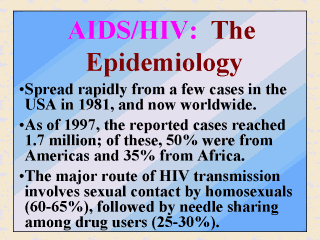 |
In the USA, AIDS
has been spread rapidly along the Pacific Coast and other regions since 1981. By the end
of 1985, more than 10,000 American cases had been reported; most of them had died within
two years of diagnosis. By 1993, the cases in the USA had increased to more than 240,000,
with more than 145,000 deaths. At that time, those cases represented about 15% of the
world number. Yet according to the World Health Organization (WHO, 1997), as of November
28, 1997, the world had accumulated 1.7 million of AIDS cases. Of these, nearly 50% were
reported from the Americas, 35% from Africa, 11% from Europe, 4% from Asia, and less than
1% from Oceania. As a matter of fact, it has estimated (Science, 2000) that today
in some African countries, more than 15% of the adults (ages 15 - 46) have some signs of
HIV/AIDS. Epidemiological data (see, e.g., Foster et al., 1990; Stine,
1993) support the concept that the major route of HIV transmission involves sexual contact
by homosexual and bisexual males (60 - 65%), followed by needle sharing among injection
drug users (25 - 30%). There was also evidence showing that HIV could be transmitted
through blood transfusion, intrauterine, peripartum during birth, and breast feeding. Thus
far, the concern that HIV could be transmitted through close personal contact or insect
bites has not been empirically substantiated (Foster et al., 1990). On the other
hand, what is certain today is that HIV is being transmitted worldwide among all
age groups. |
